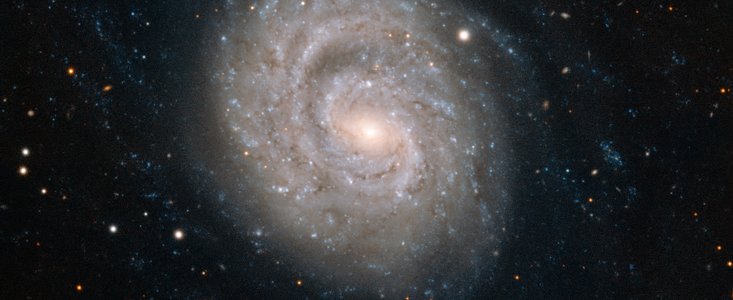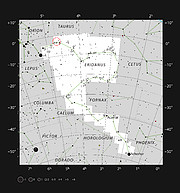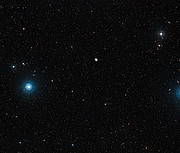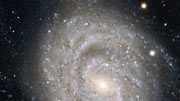Nota de prensa
Una belleza espiral adornada con una supernova que se consume
20 de Marzo de 2013
A unos 35 millones de años luz de la Tierra, en la constelación de Eridanus (El Río), se encuentra la galaxia espiral NGC 1637. Allá por 1999 la apariencia serena de esta galaxia fue eclipsada por la aparición de una supernova muy brillante. Los astrónomos que estudiaron las consecuencias de esta explosión con el telescopio VLT (Very Large Telescope) de ESO, en el Observatorio Paranal (Chile) nos han proporcionado una visión deslumbrante de esta galaxia relativamente cercana.
Las supernovas son uno de los eventos más violentos de la naturaleza. Representan la cegadora muerte de algunas estrellas y pueden eclipsar la luz combinada de miles de millones de estrellas de sus galaxias anfitrionas.
En 1999, el Observatorio Lick de California anunció el descubrimiento de una nueva supernova en la galaxia espiral NGC 1637. Fue detectada usando un telescopio construido especialmente para localizar estos escasos, pero importantes, objetos cósmicos [1]. Fueron necesarias observaciones posteriores para confirmar el descubrimiento y estudiarlo en profundidad. Esta supernova fue ampliamente observada y fue bautizada con el nombre SN 1999em. Tras su espectacular explosión en 1999, los científicos han estudiado cuidadosamente el brillo, que ha ido palideciendo lentamente con el paso de los años.
La estrella que se transformó en SN 1999em era muy masiva — más de ocho veces la masa del Sol — antes de su muerte. Al final de su vida su núcleo colapsó, lo que dio lugar a una explosión cataclísmica [2].
Durante las observaciones de seguimiento de SN 1999em, los astrónomos tomaron muchas fotografías de este objeto con el telescopio VLT, combinadas para proporcionar imágenes muy precisas de su galaxia anfitriona, NGC 1637. La estructura espiral que muestra esta imagen tiene un patrón muy diferente, con rastros azulados de estrellas jóvenes, nubes de gas brillante y caminos de polvo oscurecidos.
Pese a que, a primera vista, NGC 1637 parece un objeto bastante simétrico, tiene algunas características interesantes. Es lo que los astrónomos clasifican como galaxia espiral asimétrica: el enrollado brazo de la espiral, relativamente suelto, situado en el extremo izquierdo del núcleo, se estira a su alrededor más lejos que el brazo más compacto y corto en el extremo derecho, que aparece radicalmente cortado a mitad de camino.
En cualquier punto de la imagen, vemos dispersas estrellas más cercanas y galaxias más lejanas de las que parecen encontrarse en la misma dirección.
Notas
[1] La supernova fue descubierta por el telescopio Katzman Automatic Imaging Telescope, en el Observatorio Lick en Mount Hamilton, California (EE.UU.).
[2] SN1999em es el núcleo colapsado de una supernova clasificada con mayor precisión como de Tipo IIp. La “p” se asigna por la palabra “plateau”, que en inglés indica que la supernova de este tipo permanece brillante (estable) durante un periodo relativamente largo de tiempo tras el punto máximo de brillo.
Información adicional
ESO es la principal organización astronómica intergubernamental de Europa y el observatorio astronómico más productivo del mundo. Quince países apoyan esta institución: Alemania, Austria, Bélgica, Brasil, Dinamarca, España, Finlandia, Francia, Holanda, Italia, Portugal, el Reino Unido, República Checa, Suecia y Suiza. ESO desarrolla un ambicioso programa centrado en el diseño, construcción y operación de poderosas instalaciones de observación terrestres que permiten a los astrónomos hacer importantes descubrimientos científicos. ESO también desarrolla un importante papel al promover y organizar la cooperación en investigación astronómica. ESO opera tres sitios únicos de observación de categoría mundial en Chile: La Silla, Paranal y Chajnantor. En Paranal, ESO opera el Very Large Telescope, el observatorio óptico más avanzado del mundo, y dos telescopios de rastreo. VISTA trabaja en el infrarrojo y es el telescopio de rastreo más grande del mundo, y el VST (VLT Survey Telescope, Telescopio de Rastreo del VLT) es el telescopio más grande diseñado exclusivamente para rastrear el cielo en luz visible. ESO es el socio europeo de un revolucionario telescopio, ALMA, el proyecto astronómico más grande en desarrollo. Actualmente ESO está planificando el European Extremely Large Telescope, E-ELT, el telescopio óptico y de infrarrojo cercano de 39 metros, que llegará a ser “el ojo más grande del mundo para mirar el cielo”.
Enlaces
Contactos
Richard Hook
ESO, La Silla, Paranal, E-ELT & Survey Telescopes Press Officer
Garching bei München, Germany
Teléfono: +49 89 3200 6655
Celular: +49 151 1537 3591
Correo electrónico: rhook@eso.org
Francisco Rodríguez (Contacto para medios de comunicación en Chile)
Red de Difusión Científica de ESO
y European Southern Observatory
Teléfono: +56-2-463-3151
Correo electrónico: eson-chile@eso.org
Acerca de la nota de prensa
| Nota de prensa No.: | eso1315es-cl |
| Nombre: | NGC 1637, Supernova |
| Tipo: | Local Universe : Star : Evolutionary Stage : Supernova Local Universe : Galaxy : Type : Spiral |
| Facility: | Very Large Telescope |
| Instruments: | FORS1 |
Our use of Cookies
We use cookies that are essential for accessing our websites and using our services. We also use cookies to analyse, measure and improve our websites’ performance, to enable content sharing via social media and to display media content hosted on third-party platforms.
ESO Cookies Policy
The European Organisation for Astronomical Research in the Southern Hemisphere (ESO) is the pre-eminent intergovernmental science and technology organisation in astronomy. It carries out an ambitious programme focused on the design, construction and operation of powerful ground-based observing facilities for astronomy.
This Cookies Policy is intended to provide clarity by outlining the cookies used on the ESO public websites, their functions, the options you have for controlling them, and the ways you can contact us for additional details.
What are cookies?
Cookies are small pieces of data stored on your device by websites you visit. They serve various purposes, such as remembering login credentials and preferences and enhance your browsing experience.
Categories of cookies we use
Essential cookies (always active): These cookies are strictly necessary for the proper functioning of our website. Without these cookies, the website cannot operate correctly, and certain services, such as logging in or accessing secure areas, may not be available; because they are essential for the website’s operation, they cannot be disabled.
Functional Cookies: These cookies enhance your browsing experience by enabling additional features and personalization, such as remembering your preferences and settings. While not strictly necessary for the website to function, they improve usability and convenience; these cookies are only placed if you provide your consent.
Analytics cookies: These cookies collect information about how visitors interact with our website, such as which pages are visited most often and how users navigate the site. This data helps us improve website performance, optimize content, and enhance the user experience; these cookies are only placed if you provide your consent. We use the following analytics cookies.
Matomo Cookies:
This website uses Matomo (formerly Piwik), an open source software which enables the statistical analysis of website visits. Matomo uses cookies (text files) which are saved on your computer and which allow us to analyze how you use our website. The website user information generated by the cookies will only be saved on the servers of our IT Department. We use this information to analyze www.eso.org visits and to prepare reports on website activities. These data will not be disclosed to third parties.
On behalf of ESO, Matomo will use this information for the purpose of evaluating your use of the website, compiling reports on website activity and providing other services relating to website activity and internet usage.
Matomo cookies settings:
Additional Third-party cookies on ESO websites: some of our pages display content from external providers, e.g. YouTube.
Such third-party services are outside of ESO control and may, at any time, change their terms of service, use of cookies, etc.
YouTube: Some videos on the ESO website are embedded from ESO’s official YouTube channel. We have enabled YouTube’s privacy-enhanced mode, meaning that no cookies are set unless the user actively clicks on the video to play it. Additionally, in this mode, YouTube does not store any personally identifiable cookie data for embedded video playbacks. For more details, please refer to YouTube’s embedding videos information page.
Cookies can also be classified based on the following elements.
Regarding the domain, there are:
- First-party cookies, set by the website you are currently visiting. They are stored by the same domain that you are browsing and are used to enhance your experience on that site;
- Third-party cookies, set by a domain other than the one you are currently visiting.
As for their duration, cookies can be:
- Browser-session cookies, which are deleted when the user closes the browser;
- Stored cookies, which stay on the user's device for a predetermined period of time.
How to manage cookies
Cookie settings: You can modify your cookie choices for the ESO webpages at any time by clicking on the link Cookie settings at the bottom of any page.
In your browser: If you wish to delete cookies or instruct your browser to delete or block cookies by default, please visit the help pages of your browser:
Please be aware that if you delete or decline cookies, certain functionalities of our website may be not be available and your browsing experience may be affected.
You can set most browsers to prevent any cookies being placed on your device, but you may then have to manually adjust some preferences every time you visit a site/page. And some services and functionalities may not work properly at all (e.g. profile logging-in, shop check out).
Updates to the ESO Cookies Policy
The ESO Cookies Policy may be subject to future updates, which will be made available on this page.
Additional information
For any queries related to cookies, please contact: pdprATesoDOTorg.
As ESO public webpages are managed by our Department of Communication, your questions will be dealt with the support of the said Department.







